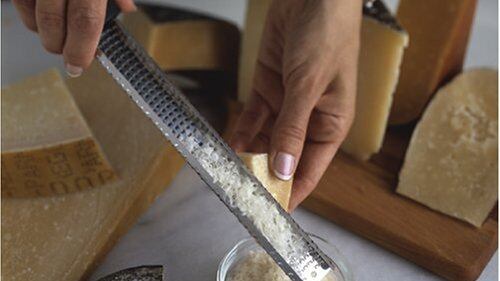By and large, I'm not a fan of specialty kitchen tools like garlic presses, herb strippers and egg slicers, for a simple reason: You can do almost everything you need to do to prepare most meals with a chef's knife and a chopping board. In my experience, these items do little but clutter up kitchen drawers, and are often priced at a premium.
RELATED: The Easiest Way To Become a Better Home Cook is By Getting a Real Chef's Knife
However, there are a small handful of items geared towards specific kitchen tasks that I find myself using very frequently—at least once a week—and which I believe are worth the investment, especially when the investment is modest. If you don't already have a microplane grater, instant-read thermometer and Y-peeler in your drawer, let me tell you why they'll make your kitchen life a little easier, and many of your meals a lot tastier.
What you use it for: Finely grating cheese, and spices, zesting citrus, grating garlic and ginger into paste.

With its long, thin blade and seemingly hoity-toity purpose—making cheese, lemon skins and spices into as tiny pieces as possible—microplane graters can seem like an imposingly decadent specialty tool solely for chefs at fine restaurants. But microplane graters are an inexpensive way to make your food taste much better and have a much more pleasant texture by giving them as much surface area as possible.
As its name suggests, a microplane grater (or zester) is basically a handheld cheese grater that slices food into millimeter-thin particles. Using it with hard cheeses gives you pillowy shreds of Parmesan and Pecorino that'll melt into pasta instantly. Using it with citrus fruit will give you brightly-flavored zest, minus the bitter pith. Using it with garlic and ginger grinds them into paste perfect for blending into dressings and marinades.
I've had Microplane's base level grater ($10.45) with a plastic handle for three years, and I use it at least three times a week. You can also get fancier ones to color-coordinate with your kitchen at a slight premium. If there's one thing on this list you should get, it's this.
What you use it for: Peeling fruits and vegetables.

When I first started working in kitchens in high school, I noticed that prep cooks could tear through huge piles of fruits and vegetables with weird peelers that let them turn a fruit or vegetable with one hand while peeling away with a "toward" motion with the other. When we grew up, we used crescent peelers, and the cook explained to me that I was a stupid asshole who wasted his time and increased risk of injury by having to cut towards his hands for doing so. I haven't used a crescent peeler since.
Like all kitchen equipment, there are many fancy, expensive variants available. For my money, I've used simple steel Y-peelers, which you can get in a 2 pack for $12 from Zena Swiss. Pro tip: the little hook thing on the side of the blade is used to dig out eyes in potatoes and other blemishes.
Instant-Read Thermometer

What it's used for: Instantly taking the temperature of your food.
Here we have the fanciest tool on the list. An instant read thermometer is a battery-powered device that uses a computer to instantly, accurately relay to you the temperature of your food.
If you eat meat, there's no better way to ensure that your food is cooked to the correct temperature. Traditional thermometers are slow and inaccurate, but the power of science contained within an instant read thermometer instantly tells you when your food is done. This is very nice if you are like me and eat chicken all of the time.
These things start as low as $10, but because computers are involved, upscale models can start to push $50. I use the Javelin from Lavatools, which is in the midrange at about $25 (with Prime), and comes with a retractable probe, plus a magnet so you can stick it on the fridge. Most importantly, you can buy it in a bunch of different colors.
(Cool Stuff is a new feature at Willamette Week where we feature product reviews, roundups, sales and other commerce and shopping-oriented content. All Cool Stuff reviews are editorially independent, meaning we provide honest reviews and aren't paid by the brands we write about. If you do choose to purchase something after following one of our links, Willamette Week may receive a commission, which helps fund our journalism.)
